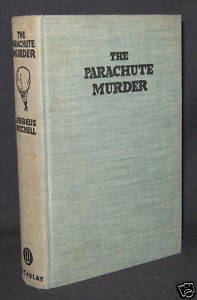The Parachute Murder–Lebbeus Mitchell 1933
 I know, you’re thinking, oh that Lebbeus Mitchell! The one who wrote a single mystery and then either stopped writing, or readers politely declined buying the book. I was bummed to learn that no where on the internet was an image of the dust jacket that once covered the boards. From a description on ABE, it was not only intriguing, but gave away the entire surprise to the plot, if surprise is the appropriate word for such a slow, convoluted, wackadoddle book. “In a colorful, edge-rubbed, price-clipped dust jacket depicting view of poisoning through an
I know, you’re thinking, oh that Lebbeus Mitchell! The one who wrote a single mystery and then either stopped writing, or readers politely declined buying the book. I was bummed to learn that no where on the internet was an image of the dust jacket that once covered the boards. From a description on ABE, it was not only intriguing, but gave away the entire surprise to the plot, if surprise is the appropriate word for such a slow, convoluted, wackadoddle book. “In a colorful, edge-rubbed, price-clipped dust jacket depicting view of poisoning through an

airplane window.” Considering more than three quarters of the story is focused on how someone could shoot and kill a man while parachuting from a plane, the dust jacket is unfortunate.
I marvel at the amount of people published back in the day, the exact date of this one being 1933, that were terrible writers. After the usual googling, I found this author had written a couple of children’s books, one was published by Volland in 1916, so, I guess I should give him some respect, but when it comes to the mystery field, Mr. Mitchell was lacking. When I read a really terrible Golden Age mystery, I think of all the writers trying to get published today, and who will take the POD route if they can’t find a legit publisher, and I wonder if that option was readily available back then, how many more horrifically bad crime novels would have been out there. I shudder to imagine.
“Chadwick Morne Murdered! Body of Chadwick Morne Floated to Earth by Parachute, Body of Chadwick Morne, Bullet Through Heart, Found Along Ohio Roadside.” These were the headlines in the tabloids that publicist Stephen Blake read the morning after the stunt he and Morne had planned of jumping from a plane and mysteriously disappearing for publicity, went horribly wrong. Blake saw veteran character actor Kirk Kemerson across the restaurant and remembered that not only did Kemerson act, but he assisted the police in murder puzzles from time to time. Thus the investigation begins. Blake himself is a suspect because of his past romance with Doris, Morne’s long suffering wife–also suspected, as are the other passengers on the small plane, The Silver Lark (they named airplanes like ships back then apparently) and whomever was piloting the plane following on the heels of the death airplane. Kemerson runs through all sorts of scenarios, from suicide, to accident, to someone having murdered Morne for what his wallet contained once on the ground, or death via gunshot wound from another passenger, or from the other plane. He mulls these possibilities over, along with the myriad of suspects for the entire length of the book, with none being ruled out. There’s Doris’ new love; And Vanuzzi, the mobster restaurant owner whose lover defected to Morne; Morne’s personal valet, Kiyoshi; Lt. Brewster, husband of a suicide who took her life because of Morne; and Edith Vane, passenger and companion to an astute elderly blind woman.
The ins and outs of the plot are hazy to me, even though I’ve only just finished it–they were unclear while still reading. Vanuzzi kidnaps someone, Kemerson, the detective disappears, only to be found alive impersonating various ‘characters’ in his actor’s trick bag, Kiyoshi is also murdered, Lt. Brewster is a strong suspect because of his wife’s sad demise, and it does turn out that he was the pilot of the shadow plane. All are found to be innocent of the deed. At least of Morne’s death. I think, but don’t quote me, Kiyoshi’s murder was committed by someone else for entirely other reasons. Can’t be sure, the plot thickened a bit too much.
Not a politically correct book, and how could it be?, it references Kiyoshi repeatedly with slang. “I don’t want you to get an innocent, inoffensive Jap in wrong with the police.” This line is delivered by Kiyoshi’s friend. His enemies contemptuously use ‘Jap” so often, , it grates on the nerves after awhile, even while keeping in mind the books dated content. But the Japanese are not the only ethnic group singled out. Vanuzzi is a typical Italian caricature. All bully, growls, and bravado. And we get this from a policeman-“Well, if it ain’t our old friend, Chinky Dobson.” ‘Nuf said there.
The end, with that ‘twist’ isn’t all that surprising, except that the murderer is someone the reader is primed to like, and therefore supposedly wouldn’t suspect. Mitchell fancied himself a philosopher, at least in this section as a erudite kidnapper discusses O. Henry:
“He always found the unexpected, surprising twist that brought a smile of delight to his readers. But it wasn’t life; it was art, artiface. Now, he’d have found an unexpected happy twist for an ending for the situation you and your lady find yourselves. That would be literary art. But life’s different, as you’ll soon learn. Life is brutal, cruel, malicious. It’s like the lighted candle put out by unexpected little draughts. The candle can be rekindled, but it’s a different flame. The flame that blown out, never comes back.”
I think there’s a nugget of truth there somewhere, I’m just not sure of what!
